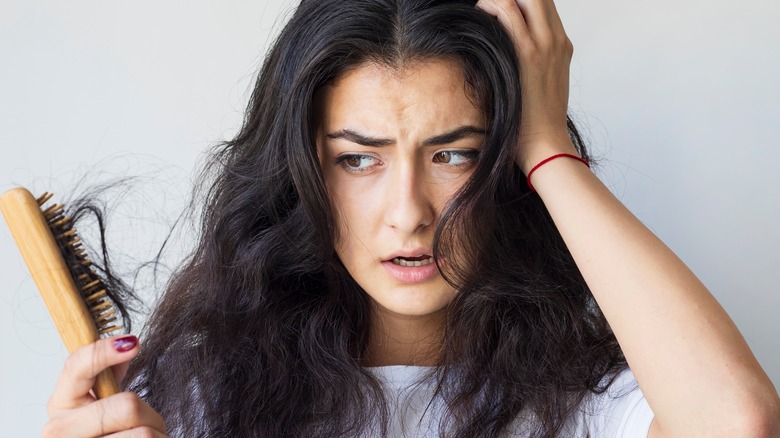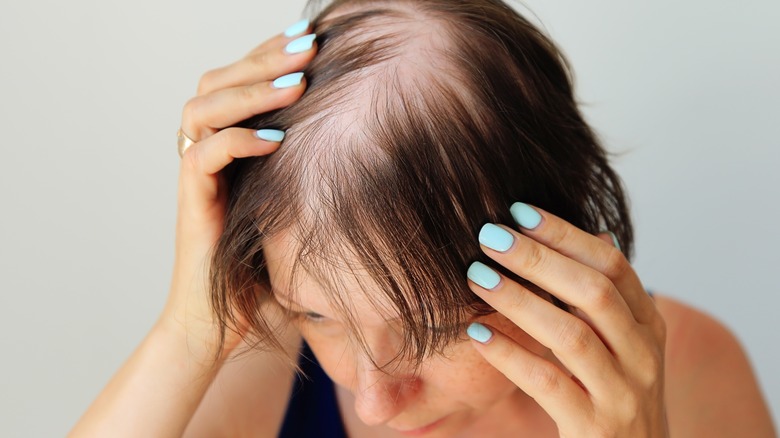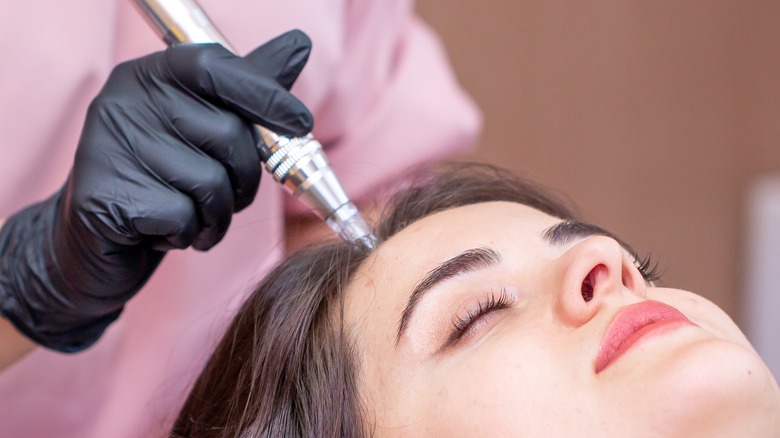How To Handle And Treat Female Hair Loss
Finding fistfuls of hair tangled in the brush bristles or falling all over the pillow is a devastating experience for any person, and yet it's especially common in women. According to Hair Loss Doctors, 25% of women suffer from thinning hair or lose hair, with 95% of female hair loss resulting from hormonal changes, such as in pregnancy or menopause. During menopause, four out of 10 women suffer with thinning hair, while over 50% of women aged 65 and above reported thinning hair. 40% of all alopecia patients are females.
Hair loss is caused by a number of factors. Among them include ringworm, genetics, postoperative complications, and childbirth, the American Academy of Dermatology Association points out. Improper hair care or too-tight hairstyles have also been linked with hair fallout. Knowing the reason for your hair loss will help you manage it successfully and take steps to stop further thinning or shedding of hair. To help those who are coping with this issue, we have gathered some tips on managing and treating hair loss.
Types of hair loss
The three major kinds of hair loss are anagen effluvium, telogen effluvium, and female pattern alopecia, according to the Cleveland Clinic. Chemotherapy, surgeries, and other medications that interfere with the growth of hair follicles can cause anagen effluvium (AE), a condition that results in the fracture of hair shafts. Telogen effluvium (TE) is a temporary excessive hair-shedding condition that typically develops shortly after a stressful or traumatic incident, such as pregnancy or substantial weight loss. Female pattern alopecia, or androgenetic alopecia, is caused by androgens in genetically susceptible individuals. The thinning or patchy hair loss for women with female pattern alopecia starts between ages 12 and 40.
Aside from these common causes, hair loss can also be triggered by underlying medical conditions. For instance, lupus, an autoimmune disease that causes widespread inflammation on the scalp, can also cause the hair on the scalp, eyebrow, or other body parts to thin out over time, per the Mayo Clinic. If your diet lacks iron or critical minerals and vitamins, like D and B12, it's also easy for your hair to become brittle and shed. Your doctor may order a few tests to rule out other possible reasons if the hair loss doesn't exhibit the classic signs of female pattern baldness, such as a thyroid function test, a complete blood count test, or a hormone test.
Hair loss treatments
Depending on the cause and extent of hair loss, the treatment options also vary substantially. Some popular hair loss treatments include Minoxidil, hormone therapy, and hair transplants. According to Harvard Health Publishing, Minoxidil, an FDA-approved topical drug sold under the name Rogaine, has been proven effective in stimulating hair growth. However, it cannot restore the full density of the lost hair. You might need to use the drug for at least six months to start seeing results, and if it works, you need to keep using it to maintain results. To amplify your treatment results with minoxidil, consider incorporating low-level light therapy. A study published in the Indian Journal of Dermatology, Venereology, and Leprology discovers that, when combined with the standard 5% minoxidil treatment for androgenetic alopecia, low-light therapy aided significantly in promoting hair regrowth.
Doctors may suggest hair transplantation as a more advanced treatment when patients don't respond well to topical or therapeutic treatments. This method includes transplanting hair follicles from one body region to another that is bald in order to promote natural hair growth there. Those who have hair loss as a result of underlying medical disorders or an imbalanced diet can keep their hair loss under control and stop additional fallout by successfully treating their medical symptoms. If you suffer minor hair loss due to clogged pores on the scalp or tight hairstyles, use shampoo designed for hair loss and let your hair down whenever you could to give your scalp a break.


